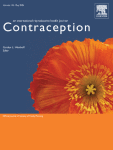Multinational comparative clinical trial of long-acting injectable contraceptives: Norethisterone enanthate given in two dosage regimens and depot-medroxyprogesterone acetate. Final report: Who special programme of research, development and research training in human reproduction*
References (9)
- et al.
Some suggested improvements of current statistical methods of analyzing contraceptive efficacy
J. Chronic. Dis.
(1976) Multinational comparative clinical trial of long-acting injectable contraceptives: norethisterone enanthate given in two dosage regimens and depot-medroxyprogesterone acetate. A preliminary report
Contraception
(1982)Multinational comparative clinical evaluation of two long-acting injectable contraceptive steroids: norethisterone enantate and medroxyprogesterone acetate: 1. Use-effectiveness
Contraception
(1977)Introduction to Stochastic Processes in Biostatistics
John Wiley and Sons
(1968)
Cited by (75)
Canadian Contraception Consensus (part 3 of 4): Chapter 8 - Progestin-only contraception
2016, Journal of Obstetrics and Gynaecology CanadaCanadian Contraception Consensus (Part 3 of 4): Chapter 8 - Progestin-Only Contraception
2016, Journal of Obstetrics and Gynaecology CanadaEctopic pregnancy with use of progestin-only injectables and contraceptive implants: A systematic review
2015, ContraceptionCitation Excerpt :Pregnancy rates in the 27 studies of injectable contraceptives were low. Among 10 studies of DMPA for which the pregnancy rate was reported or could be calculated, rates ranged from 0.1 to 1.7 per 100 woman–years [83,87,89,94,96–98,103–106]. Among studies of NET-EN, rates ranged from 0.3 to 6.6 per 100 woman–years [79,81,83,85,88,90,91,93,96,101–103].
Progestin-only contraception: Injectables and implants
2014, Best Practice and Research: Clinical Obstetrics and GynaecologyCitation Excerpt :Most women will experience irregular bleeding patterns in the first year of progestin-only contraceptive use, although irregularity reduces over time. [3,38,39] For DMPA-IM and DMPA-SC users, the proportion of women experiencing amenorrhoea increases over time (to 40–50% after 1 year and 80% after 5 years of DMPA use) [2,40–42]; these rates may be lower with NET-EN [12]. Amenorrhoea among LNG implant users is lower than among injectable users, and remains relatively constant over time (about 11%) [40].
- *
This investigation received financial support from the Special Programme of Research, Development and Research Training in Human Reproduction, World Health Organization.
- *
Department of Obstetrics and Gynaecology, University Medical School of Szeged, Szeged, Hungary
- **
Cattedra di Endocrinologia Ginecologia dell'Università di Roma, Policlinico Umberto 1o, Rome, Italy
- ***
Department of Population Dynamics, Johns Hopkins University, School of Hygiene and Public Health, 615 North Wolfe Street, Baltimore, Maryland 21205, U.S.A.

